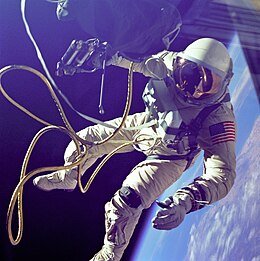Gemini IV

Edward H. White, the first American to perform extravehicular activity, outside of Gemini IV
|
|
| Operator | NASA |
|---|---|
| COSPAR ID | 1965-043A |
| SATCAT no. | 1390 |
| Mission duration | 4 days, 1 hour, 56 minutes, 12 seconds |
| Distance travelled | 2,590,600 kilometers (1,398,800 nautical miles) |
| Orbits completed | 66 (62 revolutions) |
| Spacecraft properties | |
| Spacecraft | Gemini SC4 |
| Manufacturer | McDonnell |
| Launch mass | 3,570 kilograms (7,880 lb) |
| Crew | |
| Crew size | 2 |
| Members |
James A. McDivitt Edward H. White II |
| EVAs | 1 |
| Start of mission | |
| Launch date | June 3, 1965, 15:15:59 UTC |
| Rocket | Titan II GLV, s/n 62-12559 |
| Launch site | Cape Kennedy LC-19 |
| End of mission | |
| Recovered by | USS Wasp |
| Landing date | June 7, 1965, 17:12:11 UTC |
| Landing site | North Atlantic Ocean 27°44′N 74°11′W / 27.733°N 74.183°W |
| Orbital parameters | |
| Reference system | Geocentric |
| Regime | Low Earth orbit |
| Perigee | 165 kilometers (89 nmi) |
| Apogee | 289 kilometers (156 nmi) |
| Inclination | 32.5 degrees |
| Period | 89.03 minutes |
| Epoch | June 3, 1965 |
 (L-R) White, McDivitt |
|
Gemini 4 (officially Gemini IV) was the second manned space flight in NASA's Project Gemini, occurring in June 1965. It was the tenth manned American spaceflight (including two X-15 flights at altitudes exceeding 100 kilometers (54 nmi)). Astronauts James McDivitt and Edward H. White, II circled the Earth 66 times in four days, making it the first US flight to approach the five-day flight of the Soviet Vostok 5. The highlight of the mission was the first space walk by an American, during which White floated free outside the spacecraft, tethered to it, for approximately 20 minutes. Both of these accomplishments helped the United States overcome the Soviet Union's early lead in the Space Race.
The flight also included the first attempt to make a space rendezvous as McDivitt attempted to maneuver his craft close to the Titan II upper stage which launched it into orbit, but this was not successful.
The flight was the first American flight to perform many scientific experiments in space, including use of a sextant to investigate the use of celestial navigation for lunar flight in the Apollo program.
...
Wikipedia

